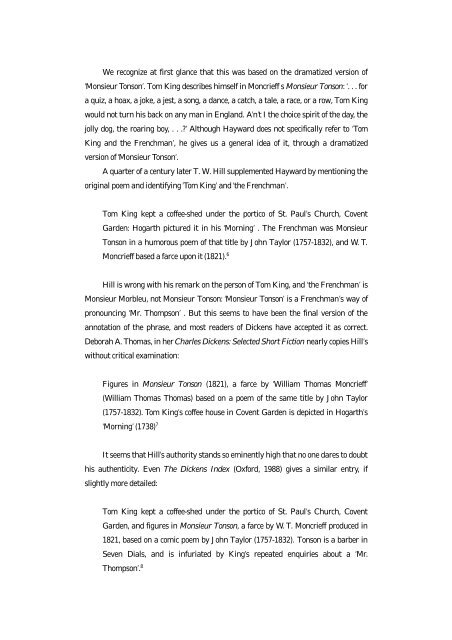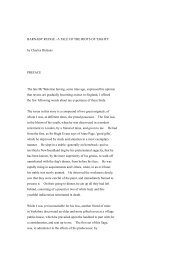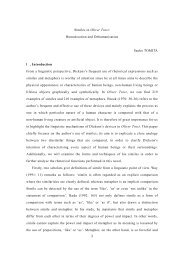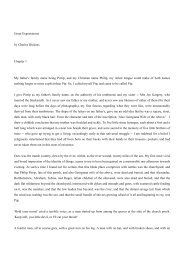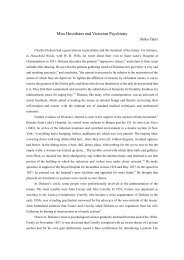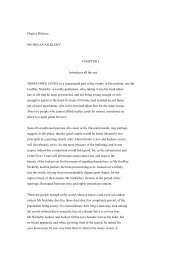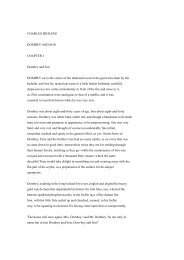T. W. Hill and 'Tom King and the Frenchman' *
T. W. Hill and 'Tom King and the Frenchman' *
T. W. Hill and 'Tom King and the Frenchman' *
You also want an ePaper? Increase the reach of your titles
YUMPU automatically turns print PDFs into web optimized ePapers that Google loves.
We recognize at first glance that this was based on <strong>the</strong> dramatized version of‘Monsieur Tonson’. Tom <strong>King</strong> describes himself in Moncrieff s Monsieur Tonson: ‘. . . fora quiz, a hoax, a joke, a jest, a song, a dance, a catch, a tale, a race, or a row, Tom <strong>King</strong>would not turn his back on any man in Engl<strong>and</strong>. A’n’t I <strong>the</strong> choice spirit of <strong>the</strong> day, <strong>the</strong>jolly dog, <strong>the</strong> roaring boy, . . .?’ Although Hayward does not specifically refer to ‘Tom<strong>King</strong> <strong>and</strong> <strong>the</strong> Frenchman’, he gives us a general idea of it, through a dramatizedversion of ‘Monsieur Tonson’.A quarter of a century later T. W. <strong>Hill</strong> supplemented Hayward by mentioning <strong>the</strong>original poem <strong>and</strong> identifying ‘Tom <strong>King</strong>’ <strong>and</strong> ‘<strong>the</strong> Frenchman’.Tom <strong>King</strong> kept a coffee-shed under <strong>the</strong> portico of St. Paul’s Church, CoventGarden: Hogarth pictured it in his ‘Morning’ . The Frenchman was MonsieurTonson in a humorous poem of that title by John Taylor (1757-1832), <strong>and</strong> W. T.Moncrieff based a farce upon it (1821). 6<strong>Hill</strong> is wrong with his remark on <strong>the</strong> person of Tom <strong>King</strong>, <strong>and</strong> ‘<strong>the</strong> Frenchman’ isMonsieur Morbleu, not Monsieur Tonson: ‘Monsieur Tonson’ is a Frenchman’s way ofpronouncing ‘Mr. Thompson’ . But this seems to have been <strong>the</strong> final version of <strong>the</strong>annotation of <strong>the</strong> phrase, <strong>and</strong> most readers of Dickens have accepted it as correct.Deborah A. Thomas, in her Charles Dickens: Selected Short Fiction nearly copies <strong>Hill</strong>’swithout critical examination:Figures in Monsieur Tonson (1821), a farce by ‘William Thomas Moncrieff’(William Thomas Thomas) based on a poem of <strong>the</strong> same title by John Taylor(1757-1832). Tom <strong>King</strong>’s coffee house in Covent Garden is depicted in Hogarth’s‘Morning’ (1738) 7It seems that <strong>Hill</strong>’s authority st<strong>and</strong>s so eminently high that no one dares to doubthis au<strong>the</strong>nticity. Even The Dickens Index (Oxford, 1988) gives a similar entry, ifslightly more detailed:Tom <strong>King</strong> kept a coffee-shed under <strong>the</strong> portico of St. Paul’s Church, CoventGarden, <strong>and</strong> figures in Monsieur Tonson, a farce by W. T. Moncrieff produced in1821, based on a comic poem by John Taylor (1757-1832). Tonson is a barber inSeven Dials, <strong>and</strong> is infuriated by <strong>King</strong>’s repeated enquiries about a ‘Mr.Thompson’. 8


